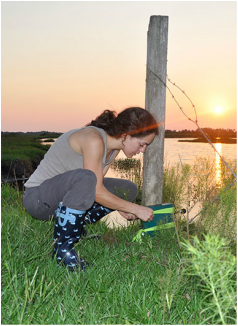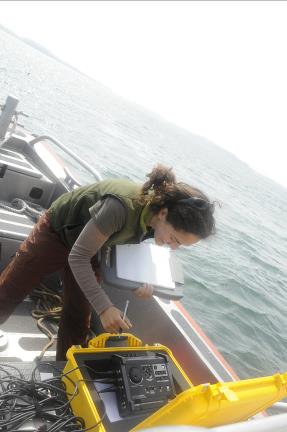|
Jenny Tennessen
NOAA Postdoctoral Researcher, NOAA Email: [email protected] Curriculum Vitae Education BS 2005 University of Wisconsin—Madison MS 2009 University of Wisconsin—Madison Research Interests Environmental noise is an increasingly common occurrence globally due to anthropogenic activities including shipping, transportation, naval operations and industrial activities. These sounds are relatively recent in evolutionary history, and have created novel acoustic environments that pose new challenges to ecological interactions among organisms. Many species rely on sounds for communication, foraging, defense, reproduction and navigation, and increasing noise across habitats may alter these abilities in new ways. My research is broadly focused on identifying how novel acoustic environments affect ecological processes and interactions among organisms. I approach this problem from three different angles, using three different case studies. First, I employ sound propagation modeling (parameterized by data from opportunistic observations) to determine how shipping noise reduces the communication ranges between North Atlantic right whales (Eubalaena glacialis). This project focuses on communication between mothers and calves during separation just prior to weaning in the Bay of Fundy, as well as communication between reproductive females and males. My goal is to determine how communication range of this highly endangered species is affected by shipping noise, as well as how noise reduces human abilities to passively detect North Atlantic right whale calls for management and conservation purposes. My second project employs passive acoustic monitoring and field acoustic playback techniques to determine if an invasive species, the Cuban treefrog (Osteopilus septentrionalis) competes for acoustic space with native treefrogs in south-central Florida. This project explores how competition structures acoustic communities and seeks to identify a novel pathway through which invasive species can alter ecological communities. My third project uses field and lab playbacks, and immunological techniques to understand the effects of noise on physiology and fitness. Working with wood frogs (Rana sylvatica) in central Pennsylvania, I am particularly interested in determining if noise impedes reproductive opportunities, and identifying the relationship between noise and stress hormone levels, as an indicator of fitness effects of noise exposure. |
Publications
Swierk L.S., Tennessen J.B. and Langkilde T. 2015. Sperm depletion may not limit male reproduction in a capital breeder. Biological Journal of the Linnean Society, published online doi:10.1111/bij.12603. Tennessen J.B., Parks S.E. and Langkilde T. 2014. Traffic noise causes physiological stress and impairs breeding migration behavior in frogs. Conservation Physiology 2: doi:10.1093/conphys/cou032. |

